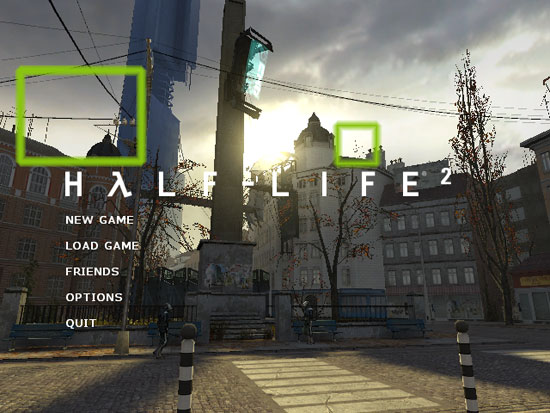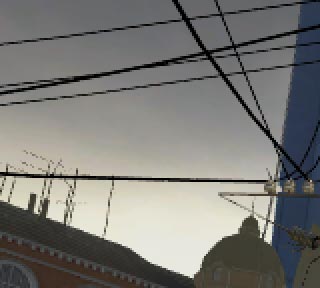NVIDIA's GeForce 8800 (G80): GPUs Re-architected for DirectX 10
by Anand Lal Shimpi & Derek Wilson on November 8, 2006 6:01 PM EST- Posted in
- GPUs
All of our image quality comparisons are 200 - 400% zooms on the two highlighted areas of the following image:

What really matters are image quality and performance. Does CSAA provide equivalent or better image quality to MSAA methods? We take a look at Half-Life 2 to find out. First up, we compare CSAA and MSAA in modes where only 4 color/z values are stored.

4X 8X 16X
Hold mouse over links to see Image Quality

4X 8X 16X
Hold mouse over links to see Image Quality
We can clearly see that, using only 4 sample points, CSAA is able to achieve greater AA quality. Edges are smoother and thin lines appear less broken. But what happens when we look at an MSAA mode with more sample points than CSAA.

8X 8XQ
Hold mouse over links to see Image Quality

8X 8XQ
Hold mouse over links to see Image Quality
Here we can see that NVIDIA's 8x and 8xQ modes provide similar quality. The higher number of multisamples employed by 8xQ does seem to have a positive impact on thin line antialiasing, as seen with the antenna. Edges look about the same though.










111 Comments
View All Comments
dwalton - Thursday, November 9, 2006 - link
When using older cards sacrificing IQ for performance is typically acceptable. Who needs AA when running F.E.A.R on a 9700 Pro.However, on a just launched high-end card, why would anyone feel the need to sacrifice IQ for performance? Some may say resolution over AA, but I find it hard to believe that there is a lot of gaming enthusiasts with deep pockets, who play with insane resolutions yet no AA.
JarredWalton - Thursday, November 9, 2006 - link
If I look for jaggies, I see them. On most games, however, they don't bother me much at all. Running at native resolution on LCDs or at a really high resolution on CRTs, I'd take that over a lower res with 4xAA. If you have the power to enable 4xAA, great, but I'm certainly not one to suggest it's required. I'd rather be able to enable vsync without a massive performance hit (i.e. stay above 60 FPS) than worry about jaggies. Personal preference.munim - Wednesday, November 8, 2006 - link
"With the latest 1.09 patch, F.E.A.R. has gained multi-core support,"Where is this?
JarredWalton - Wednesday, November 8, 2006 - link
I wrote that, but it may be incorrect. I'm trying to get in contact with Gary to find out if I'm just being delusional about Quad Core support. Maybe it's NDA still? Hmmm.... nothing to see here!JarredWalton - Wednesday, November 8, 2006 - link
Okay, it's the 1.08 patch, and that is what was tested. Since we didn't use a quad core CPU I don't know if it will actually help or not -- something to look at in the future.Nelsieus - Wednesday, November 8, 2006 - link
I haven't even finished reading it yet, but so far, this is the most comprehensive, in-depth review I've seen on G80 and I just wanted to mention that beforehand.:)
GhandiInstinct - Wednesday, November 8, 2006 - link
What upcoming games will be the first to be fully made on DX10 structure? And does the G80 have full support of DX10?timmiser - Thursday, November 9, 2006 - link
Microsoft Flight Simulator X will be DX10 compliant via a planned patch once Vista comes out.JarredWalton - Wednesday, November 8, 2006 - link
All DX10 hardware will be full DX10 (see pages 2-4). As for games that will be DX10 ready, Halo 2 for Vista will be for sure. Beyond that... I don't know for sure. As we've explained a bit, DX10 will require Vista, so anything launching before Vista will likely not be DX10 compliant.shabby - Wednesday, November 8, 2006 - link
They're re-doing a dx8 game in dx10? You gotta be kidding me, whats the point? You cant polish a turd.